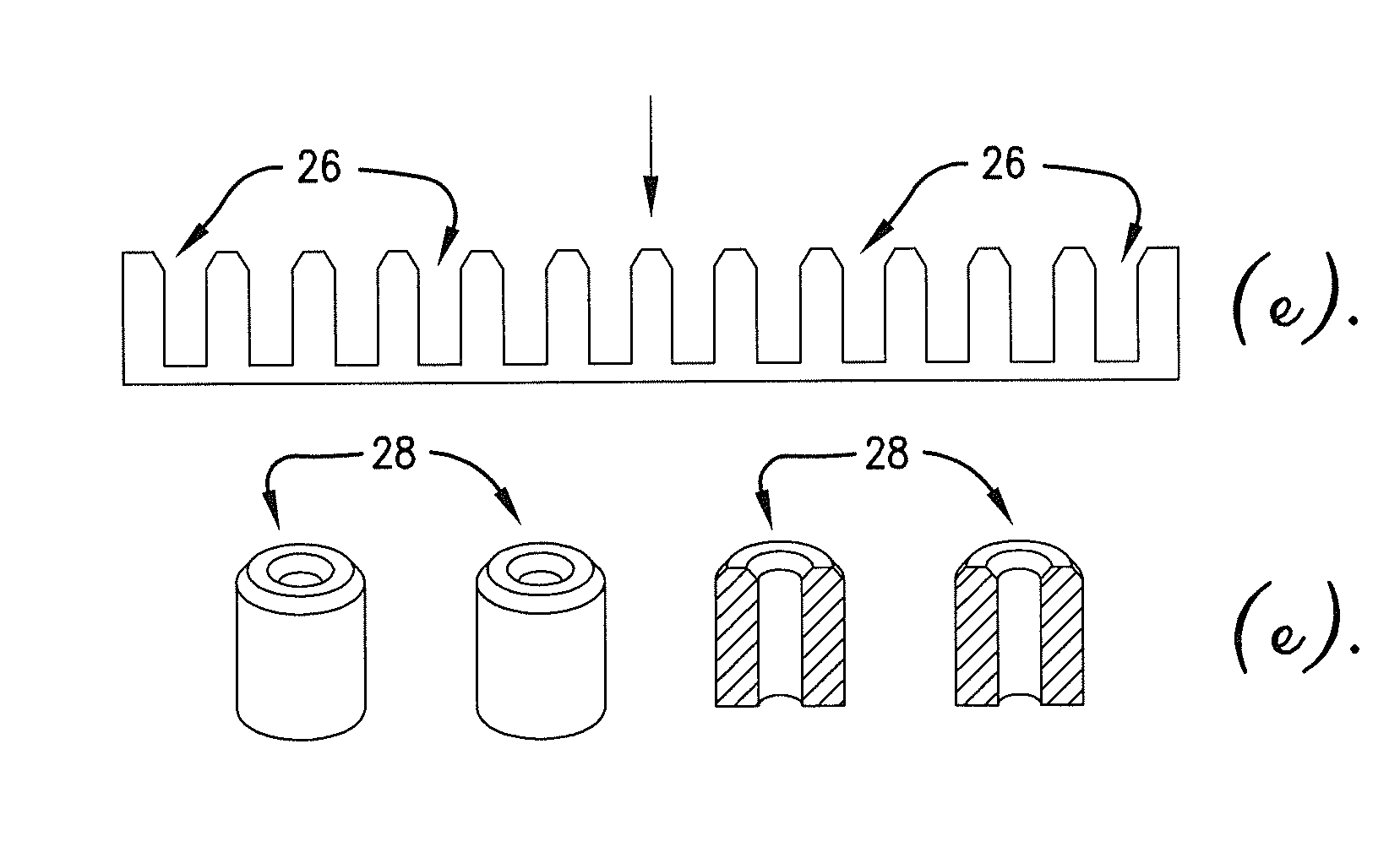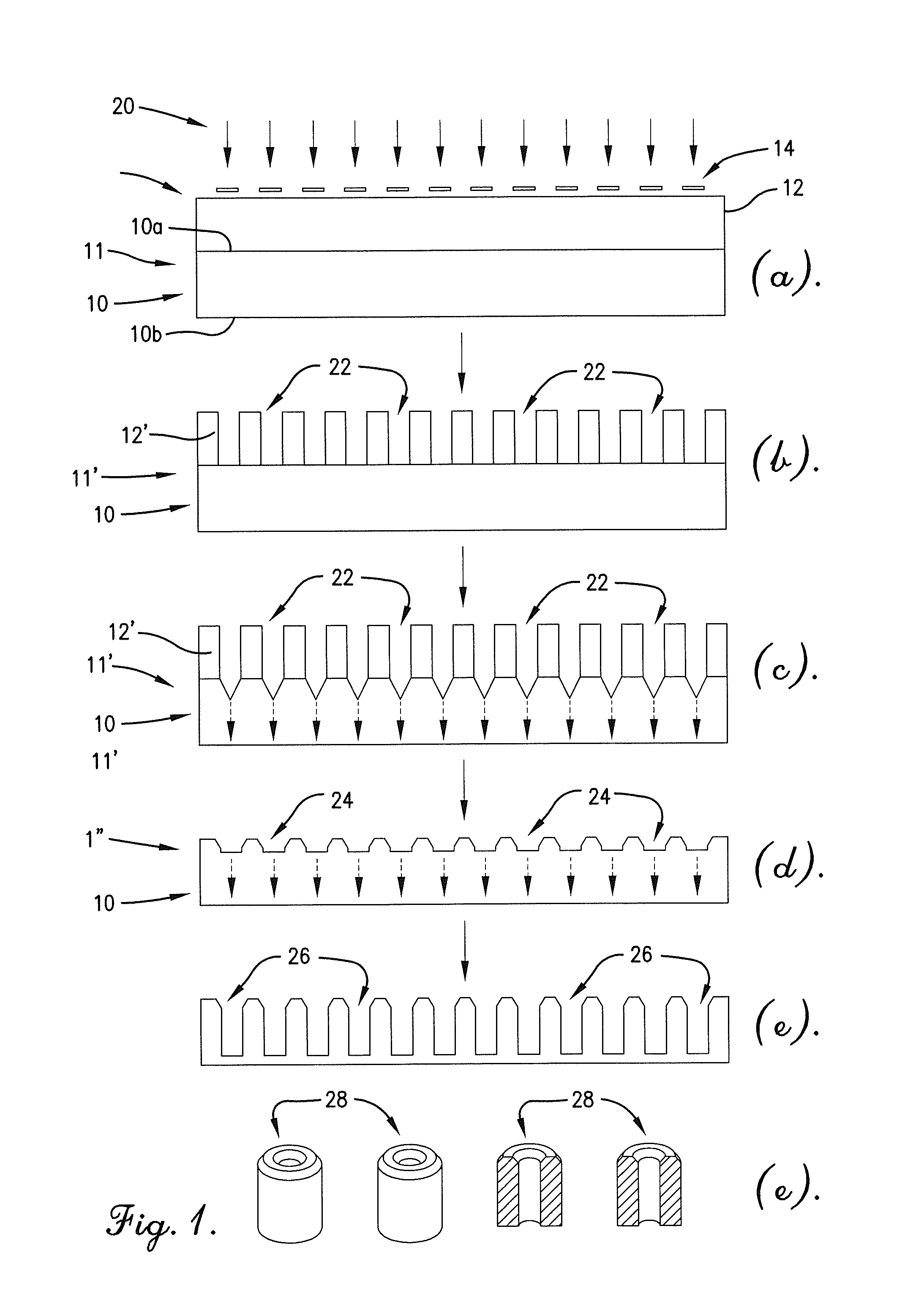Cvd-free, scalable processes for the production of silicon micro- and nanostructures
a technology of micro- and nanostructures, which is applied in the direction of photomechanical treatment originals, instruments, photomechanical equipment, etc., can solve the problems of inability to scale up production, less desirable for large-scale manufacturing, and high cost of tooling for deep reactive ion etching (drie) methods, and the need for a long process time to complete the manufacturing cycl
- Summary
- Abstract
- Description
- Claims
- Application Information
AI Technical Summary
Benefits of technology
Problems solved by technology
Method used
Image
Examples
example 1
Production of Orderly Array of Microscale Silicon Pores
[0087]A special mask with 4-μm circles was designed. Silicon substrates with low resistivity (1-2 Ω·cm) were used. The silicon substrate was first coated with ProTEK® PSB primer material (Brewer Science, Inc., Rolla, Mo.) at 1,000 rpm and 1,000 rpm / sec for 60 seconds. The primer underlayer was subjected to a two-stage bake, first at 110° C. for 60 seconds and then at 220° C. for 5 minutes. The primer layer was then solvent-stripped by use of a 20-second puddle of PGME (Sigma-Aldrich, St. Louis, Mo.). The silicon wafer with primer layer was then spin dried at 2,000 rpm and 10,000 rpm / sec for 20 seconds. This wafer was then spin-coated with diluted ProTEK® PSB material (11.5% solids, Brewer Science, Inc., Rolla, Mo.) at 1,500 rpm and 1,000 rpm / sec for 60 seconds. The coated wafer was then baked at 110° C. for 120 seconds. The substrate was then exposed on a SUSS mask aligner (broadband exposure at 250 mJ / cm2 measured at 365 nm), f...
example 2
Production of Orderly Array of Microscale Silicon Tubes
[0092]A special mask with 20-μm rings and 5 micron dots was designed to create the outer and inner walls of the tubes, respectively. Silicon substrates with low resistivity (1-2 Ω·cm) were used. Without the use of ProTEK® PSB primer, the silicon wafer was then spin-coated with diluted ProTEK® PSB material (5.75% solids, Brewer Science, Rolla, Mo.) at 1,500 rpm and 1,000 rpm / s for 60 seconds. The coated wafer was then baked at 110° C. for 120 seconds. The substrate was exposed to the outer wall pattern on a SUSS mask aligner (broadband exposure at 250 mJ / cm2, measured at 365 nm), followed by post-exposure bake (PEB) at 110° C. for 2 minutes. Following the PEB, the substrate was developed using ethyl lactate (Sigma-Aldrich, St. Louis, Mo.) for a total of 90 seconds (dynamic dispense, with 5-second on / off dispense). The developed wafer was rinsed with isopropyl alcohol (Sigma-Aldrich, St. Louis, Mo.) for 30 seconds, and a final bak...
example 3
Production of Orderly Array of Microscale Silicon Tubes
[0098]A special mask with 25-μm rings and 5 micron dots was designed to simultaneously create the outer and inner walls of the tubes, respectively. Silicon substrates with low resistivity (1-2 Ω·cm) were used. ProTEK® PSB primer was used as an underlayer. The silicon wafer was spin-coated with diluted ProTEK® PSB primer (Brewer Science, Inc., Rolla, Mo.) at 2,500 rpm and 10,000 rpm / sec for 60 seconds. The coated wafer was then baked at 110° C. for 60 seconds, followed by 220° C. for 5 minutes. The primed wafer was solvent stripped using PGMEA for 52 seconds. The silicon wafer was spin-coated with diluted ProTEK® PSB material (5.75% solids, Brewer Science, Inc., Rolla, Mo.) at 2,500 rpm and 10,000 rpm / sec for 60 seconds. The coated wafer was baked at 110° C. for 120 seconds. The substrate was then exposed to create both outer and inner wall patterns on a SUSS mask aligner (broadband exposure at 250 mJ / cm2 measured at 365 nm), fol...
PUM
 Login to View More
Login to View More Abstract
Description
Claims
Application Information
 Login to View More
Login to View More - R&D
- Intellectual Property
- Life Sciences
- Materials
- Tech Scout
- Unparalleled Data Quality
- Higher Quality Content
- 60% Fewer Hallucinations
Browse by: Latest US Patents, China's latest patents, Technical Efficacy Thesaurus, Application Domain, Technology Topic, Popular Technical Reports.
© 2025 PatSnap. All rights reserved.Legal|Privacy policy|Modern Slavery Act Transparency Statement|Sitemap|About US| Contact US: help@patsnap.com



